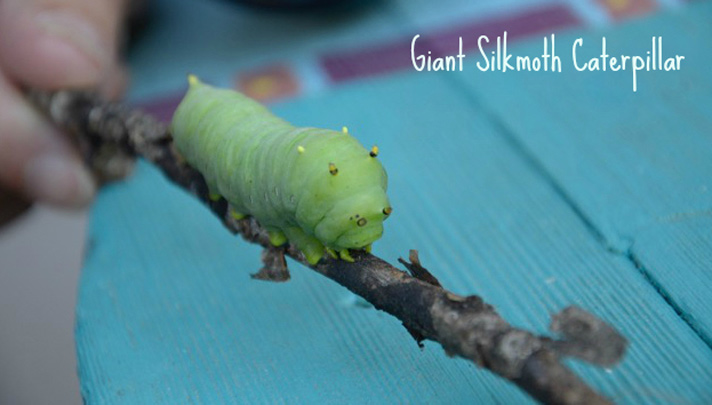Love Thy Pollineighbor – November 2016
He looked like something out of the cartoons, a dazzling green blubbery caricature of himself. Given his lazy, lumbering gait, this little guy was in no hurry to get to his destination.
I inspected him closely, intrigued by his suction cup feet, the wrinkles in the fern-green folds of his skin, and those curious yellow spikes. What in the world was this unworldly creature? I knew him to be a caterpillar, but what kind? Given the impressive size, maybe Luna Moth?
I consulted with my favorite go-to Bugman (www.WhatsThatBug.com), Daniel Marlos, who holds an infinite wealth of information about all things insects.
“These are Giant Silkmoth Caterpillars from the family Saturniidae and the genus Hyalophora. There are two species from the genus in Oregon.”
Are they pollinators? If not, what’s their role in nature?
“Caterpillars are not considered pollinators in the traditional sense … but … they might accidentally transfer pollen from one blossom to another while eating leaves…
We have a long-standing mission on our site to promote the interconnectivity of all forms of life on our planet. Giant Silkmoths store vast quantities of fat in their bodies to help them survive as adults, …[they] provide a valuable source of nutrition to many predators, including bats, birds and mammals.”
The Giant Silkmoth Caterpillar pupates, in a silken cocoon, on its host plant, in leaf litter, or in crevices, rocks and logs. Host plants include manzanitas, madrones, and alders.
Some caterpillars attach their cocoons to trees, which fall to the ground resembling leaf litter to unsuspecting predators. Many insects, including native bees, overwinter their larvae in sheltered spaces such as leaf debris or dead plant material like stems. These visitors in your yard will later keep destructive insects under control; others may help pollinate plants.
Christie Mackison, co-owner and landscape designer at Shooting Star Nursery (www.roguevalleynursery.com) shared insights on autumn yard care that helps beneficial insects:
“I am always telling people to save the major cleanup in the garden for spring. The faded stems and decaying leaves can provide great habitat for overwintering beneficial insects. I always find ladybugs hiding in the Lamb’s Ear when I go to clean it up in the spring. Ornamental grasses provide places for beneficial insects to hide over the winter. The seed heads of perennials, grasses, and shrubs can provide food for birds and other wildlife as well over the winter. Plus the foliage and stems you leave can help protect the crown of the plant from rotting out over the winter. Usually mid-March is a good time to get out in the garden and do your major cleanup. You will be rewarded with a supply of good bugs to help you in the garden.”
So while most folks are busily cleaning up dead plants and leaves, be a pollinactivist this fall! Preserve natural spaces in your yard. It’s a great excuse to give yourself a respite in the name of environmental stewardship. Say Yes to the Mess! Your pollineighbors will love it.

 When she’s not working, volunteering, fiddling about the garden, photographing nature, being a pollinactivist, blogging about social and environmental justice, or pawning her eco-children’s book, Kenda, a former Monarch butterfly docent, gets her kicks hanging with her husband, her dog, and the pollineighbors.
When she’s not working, volunteering, fiddling about the garden, photographing nature, being a pollinactivist, blogging about social and environmental justice, or pawning her eco-children’s book, Kenda, a former Monarch butterfly docent, gets her kicks hanging with her husband, her dog, and the pollineighbors.